Planning a trip to Saudi Arabia? Here’s what you need to know to travel to Saudi Arabia, from costs to what to wear to safety and cultural deets. Happy planning!
Saudi Arabia has long been closed off for most travelers. Restrictive visa policies meant only Muslims—or oil industry workers—could visit. Even then, they could only visit a few places in the country.
Then everything changed in 2019. *Cue Avatar: The Last Airbender theme*
Saudi Arabia is currently making a big push to rebrand itself as a premier holiday destination in the Middle East. Part of that push involves a more open e-visa policy. This new visa regime makes it significantly easier for many nationalities to visit the country. It also allows pilgrims on Hajj and Umrah to travel beyond Mecca and Medina.
Whether or not Saudi Arabia is a top travel destination is another matter, but if you plan on visiting Saudi Arabia, you definitely need to come prepared to avoid offense. Read on to learn all the things I wish I’d known before traveling to Saudi Arabia!
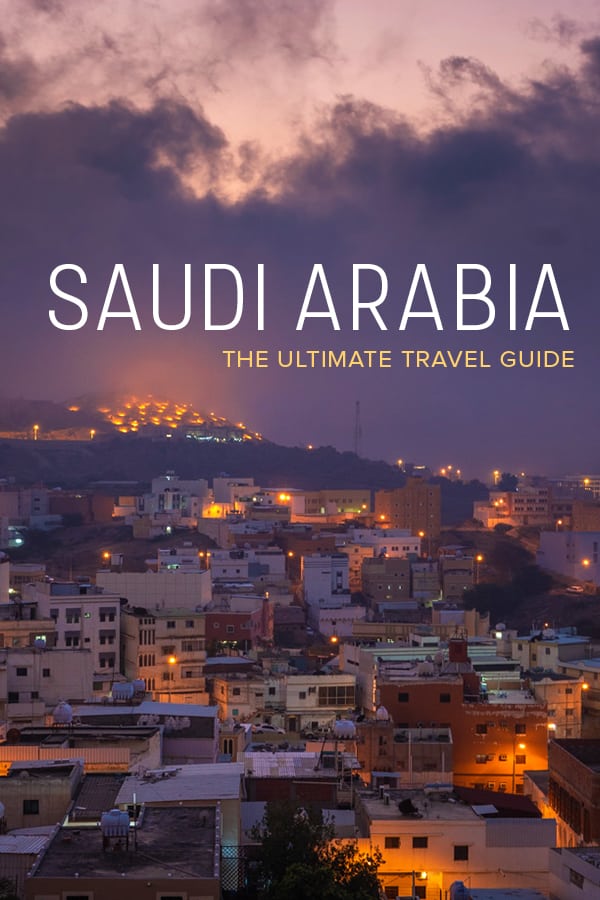
Saudi Arabia travel guide: here’s what you need to know
- Saudi Arabia basics
- Best time to visit Saudi Arabia
- Visa for Saudi Arabia
- What to pack
- Language in Saudi Arabia
- Religion in Saudi Arabia
- Culture in Saudi Arabia
- Clothes and what to wear
- Gender and how to act
- Hospitality and gift giving
- Female travel in Saudi Arabia
- Food in Saudi Arabia
- Eating customs
- Traveling as a vegetarian/vegan
- Money and payments
- Transportation
- Safety in Saudi Arabia
- Mobiles and connectivity
- Travel resources
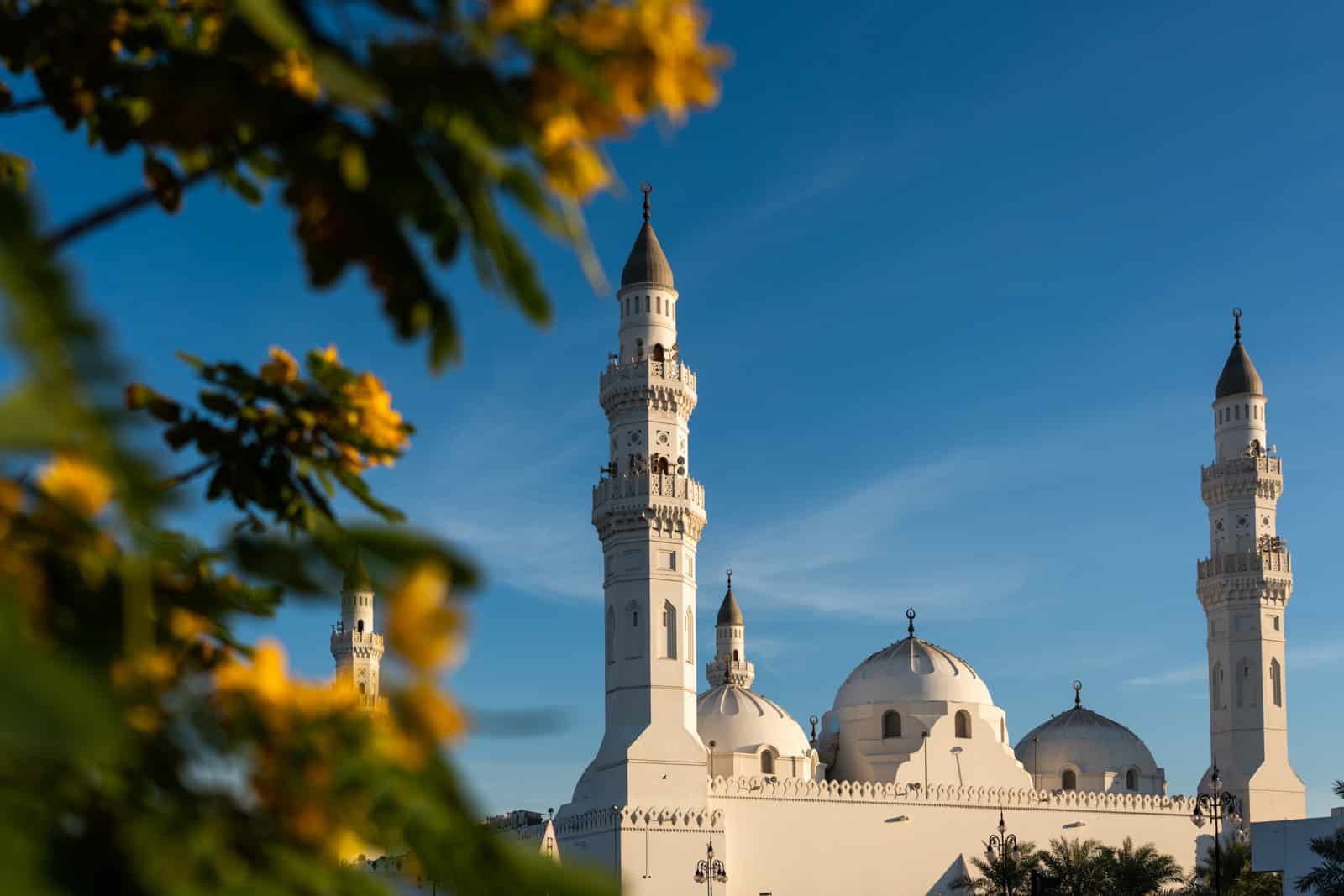
Quba mosque in Medina, said to be the first mosque ever built.
Saudi Arabia basics
- Official name: Kingdom of Saudi Arabia (KSA)
- Capital: Riyadh
- Population: 34 million
Saudi Arabia is the 12th largest country in the world by landmass. Its population is youthful; of the approximately 34 million people living in the country, 50% are younger than 25.
Expats (foreigners) make up a significant part of its population—more than 30% of people living in KSA are foreign nationals. Interestingly enough, this foreign minority makes up more than 70% of Saudi’s workforce. Interpret that how you will.
The kingdom in its current form was founded in 1932 as an absolute monarchy. This means most of the power in Saudi Arabia lies in the hands of the royal family, the House of Saud, who rule the kingdom to this day. The current monarch is King Salman… but his son, Mohammed bin Salman (also known as MBS), more or less runs the kingdom. MBS is also responsible for the Vision 2030 program that spurred the recent tourism developments.
The Arabian peninsula is the founding place of Islam, one of the world’s largest religions. Its two holiest cities, Medina and Mecca, are both in Saudi Arabia. They are the main destinations of the Hajj and Umrah pilgrimages that millions of Muslims from around the world undertake every year. Religion is critical in Saudi Arabia; for more on religion in Saudi Arabia, see the religion section.
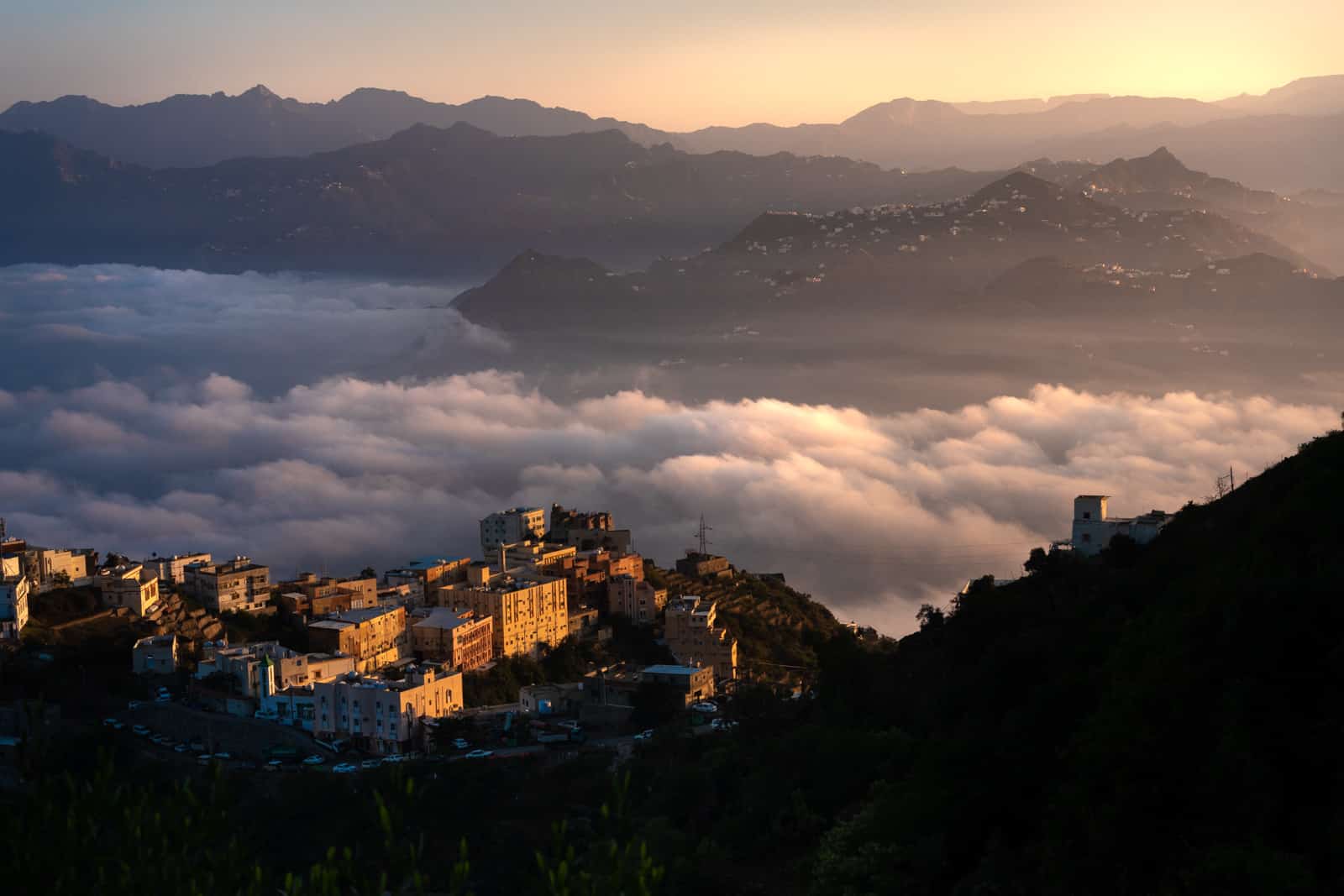
Sunrise above the clouds in Fayfa. Not bad, eh?
When’s the best time to visit Saudi Arabia?
Definitely do not visit Saudi Arabia in summer.
Summers in Saudi can be boiling hot, with temperatures exceeding 40°C. Unless you’re a masochist, it’s best to avoid traveling to Saudi in summer. The mountains of Asir province are one notable exception to the summer rule; though temperatures can still be high, the cloudy, mountainous terrain is generally quite pleasant during summer.
The best time to visit Saudi Arabia is in winter, roughly between October and March. Temperatures are at their most pleasant between November and February. Temperatures typically begin rising from the end of February or beginning of March, though one can never be quite certain thanks to climate change. Winter temperatures hover around 25°C – 30°C, depending on where in the country you are.
Read: My one-month essential Saudi Arabia itinerary
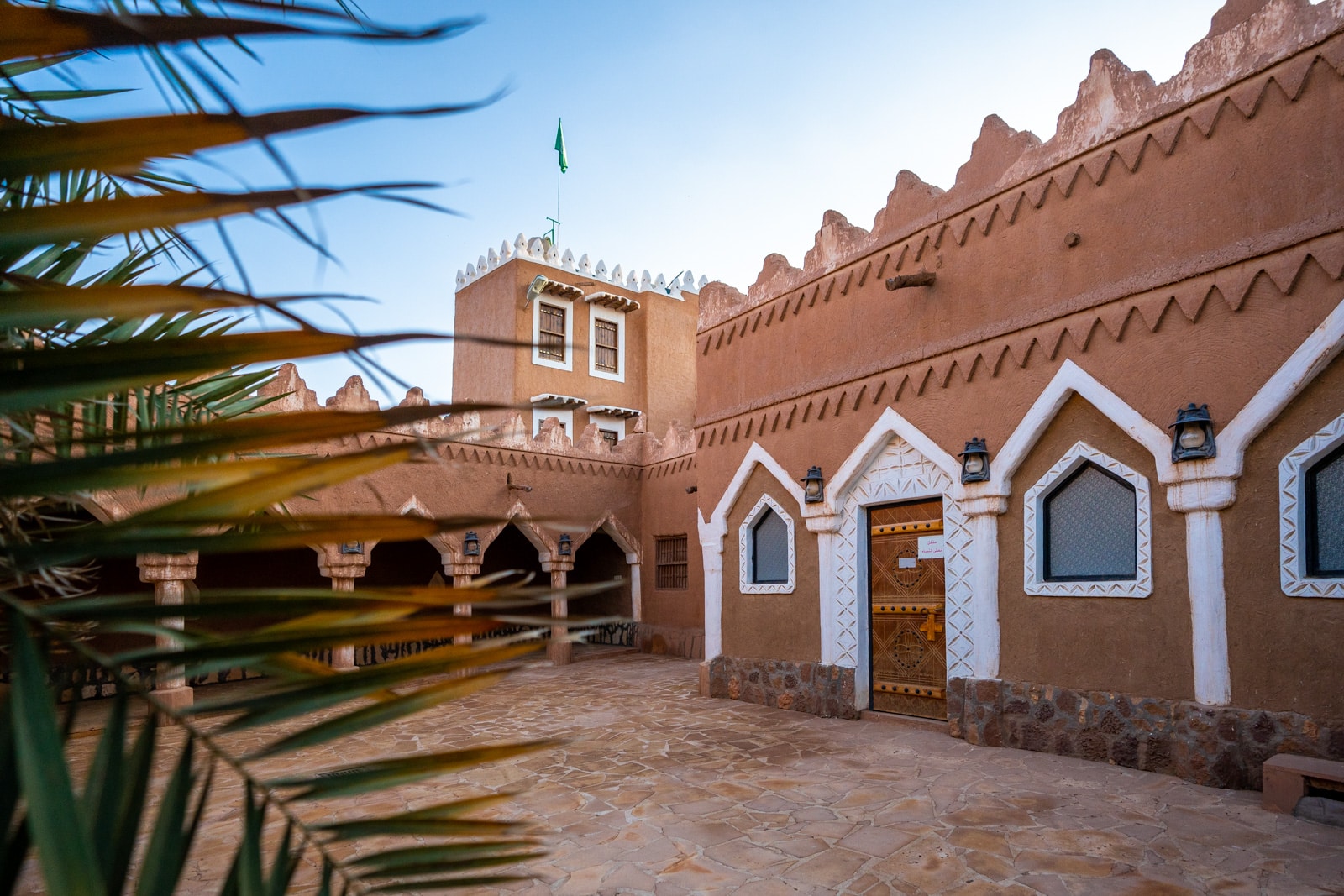
A historic sandstone mosque in Ushaiger village
Visas for Saudi Arabia
It used to be a real pain to get a Saudi Arabia visa. Unless you were a Muslim going on a pilgrimage or an exec visiting/working for business, it was nearly impossible to go to Saudi Arabia.
Before 2019, some travelers managed to get in via “business” trips booked by tour companies. Saudi Arabia began issuing tourist visas specifically for ticketed events in 2018. However, for the most part, Saudi Arabia was a non-option for the average tourist.
In 2019, everything changed with the introduction of the new e-visa system. The new Saudi Arabia e-visa system is surprisingly easy. I was legitimately taken aback when I applied—It took me less than 15 minutes to apply for my visa, I stood up to go to the bathroom after finishing the application, and by the time I returned to my computer 5 minutes later I had a Saudi Arabia e-visa PDF waiting in my Whatsapp inbox. Crazy, right?
Who’s eligible for a Saudi Arabia e-visa?
As of 2020, citizens of the following countries are eligible for a Saudi Arabia tourist e-visa:
Australia, Austria, Andorra, Belgium, Bulgaria, Brunei, Canada, China, Cyprus, Croatia, Czech Republic, Denmark, Estonia, Finland, France, Germany, Greece, Hong Kong, Hungary, Iceland, Italy, Ireland, Japan, Kazakhstan, Latvia, Liechtenstein, Lithuania, Luxembourg, Macau, Malaysia, Malta, Monaco, Montenegro, Netherlands, New Zealand, Norway, Poland, Portugal, Romania, Russia, San Marino, Singapore, Slovakia, Slovenia, South Korea, Spain, Sweden, Switzerland, Ukraine, United Kingdom.
For more detailed and up-to-date information on visa eligibility, how much the visa costs, and to apply for Saudi’s e-visa, check out the official Saudi Arabia e-visa website.
Important note: Several fake e-visa websites have popped up. Do not use any website except the official Saudi Arabia e-visa site to apply for your visa.
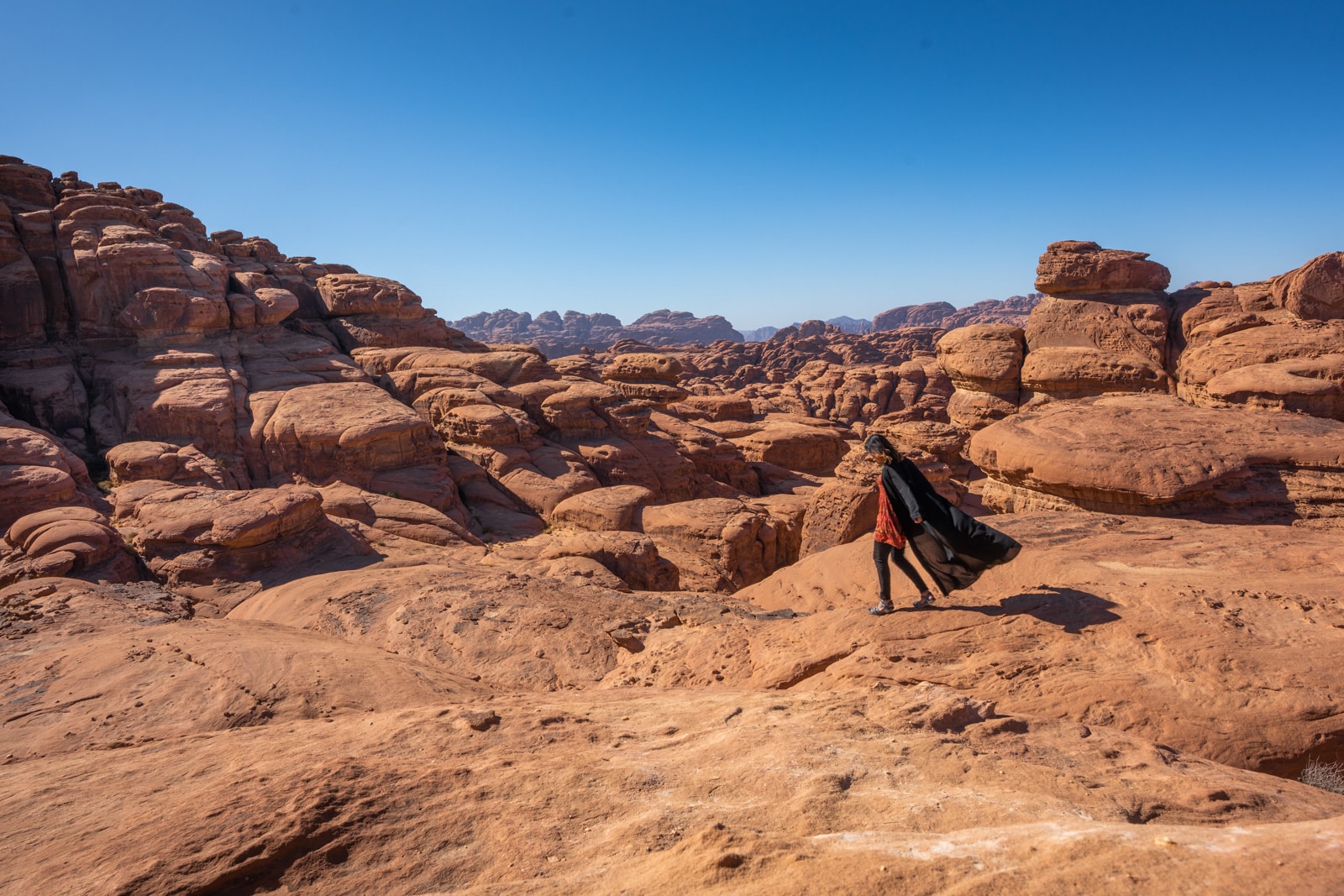
Scrambling around in the northern Tabuk region.
What to pack for travel in Saudi Arabia
Everyone has different needs, but there are a few items I strongly recommend you pack when traveling in Saudi Arabia:
- Modest clothes. This one is a given—Saudi is an Islamic country, after all—but men and women alike need to make an effort to stay covered up.
- Travel adapter. Saudi uses the same G-type plugs (3 rectangular holes) that you find in the UK. If you’re coming from Europe or the US, you’ll need a travel adapter for Saudi Arabia. I always travel with several of these adapters since they also have USB outlets.
- Reusable water bottle. Plastic waste is a huge issue in Saudi Arabia, and people love to buy painfully tiny plastic bottles of water. Do your part for the planet—bring your own water bottle. Tap water is generally safe to drink, and water filters are common in metro areas. I love and recommend my Hydroflask insulated water bottle. It also kept water cold when it was boiling hot!
- Reusable cup for coffee/tea/cold drinks. Same environmental logic applies. They’re seriously useful if you’re road tripping across Saudi Arabia—you’ll be drinking a lot of tea and coffee from rest stops along the highways! These travel mugs are great, and insulate both hot and cold drinks.
- Good sunscreen. Saudi sun is fierce, and the dry heat combined with sun can be seriously hard on your skin. Plus you’re going to get some freaky tan lines from all your modest clothing! I always travel with this specific sunscreen because it doesn’t feel slimy or sticky in the slightest.
- Arabic phrasebook. English isn’t very common, especially outside cities. I used Google Translate often… but no one understood me, and it was total crap at translating Saudi’s Arabic dialect. I highly recommend this Arabic phrasebook—it’s specific to one of the major dialects in KSA.

Typical roadside decor in Saudi.
Language in Saudi Arabia
The official language of Saudi Arabia is—yep, you guessed it—Arabic.
However, Arabic is more nuanced than non-Arabic speakers might realize. Arabic spoken in, say, Morocco, is far different from the Arabic you’ll hear in Saudi Arabia.
The three main variants of Arabic spoken in Saudi are:
- Najdi Arabic
- Hejazi Arabic
- Gulf Arabic
It’s both useful and respectful to pick up some basic Arabic or have a phrasebook on hand for short interactions. Careful, as most Arabic phrasebooks are written for Moroccan or Egyptian Arabic; I specifically recommend using this Hejazi Arabic phrasebook, which covers one of the main dialects you’ll encounter in Saudi Arabia. Never fear, it doesn’t require any struggling with the Arabic alphabet—all the phrases are written in the Roman alphabet.
English in Saudi Arabia? English isn’t widely spoken in Saudi, though people in the tourism sector will often speak some English. More and more young Saudis speak English, as many study abroad for university. Most road signs on main roads are written with both Arabic and Roman alphabets, though speed limit signs are Arabic-only once you get away from Jeddah and Riyadh.
Due to the large number of foreigners living in Saudi—roughly 30% of Saudi’s population comes from abroad—it’s also common to hear people speak Tagalog, Urdu, and Hindi, among other languages. Many of the labor or customer service workers you’ll run into in Saudi are from India, Pakistan, and the Philippines; you can easily travel in many places without Arabic if you speak some Hindi/Urdu. Speaking from experience.
The Arabic alphabet
The Arabic alphabet is written from right to left, and, in my humble opinion, complicated AF. Many letters are drastically different depending on where in the word they fall (beginning/middle/end) and a single dot can change the entire sound of a letter.
Despite its complexity, learning just a handful of letters can be immensely helpful for figuring out signs and differentiating between options. I used the free app Duolingo to learn the Arabic alphabet while traveling in Saudi Arabia. And by learn, I mostly mean shouting exasperatedly at my phone as it asked me to make guttural noises and read incomprehensible squiggles, neither of which I could never dream of reproducing.
Even if you aren’t linguistically inclined, I recommend learning Arabic numerals. They are not as difficult (there are only 10 of them, after all) and you’ll need to know them to read things like prices and speed limit signs if traveling Saudi Arabia by car.
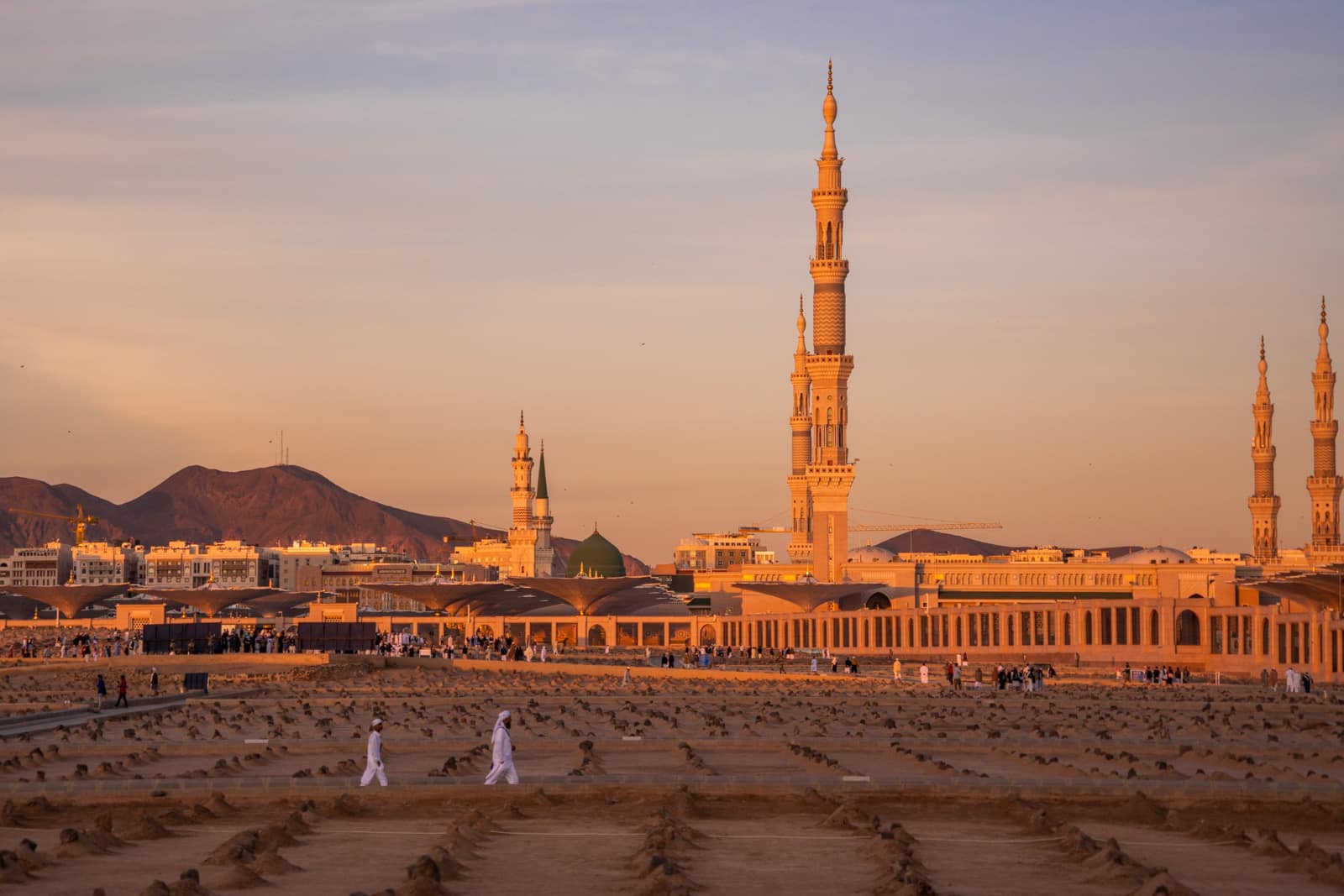
Men walking through the Al Baqi cemetery in the Haram center of Medina, one of Saudi’s holiest cities. Some of the Prophet’s family are buried in this cemetery.
Religion in Saudi Arabia
Religion influences every part of Saudi life. Saudi citizens have to be Muslim, and publicly practicing any religion other than Islam is forbidden.
Everything shuts down during namaz, prayer times. In Sunni Islam, there are five prayer times every day: fajr, duhr, asr, maghrib, and isha. The timings change slightly each day—here are today’s prayer times.
Shops, restaurants, cafes—basically everything except for fancier places hidden from sight—will close for around 15 minutes to half an hour during prayer times. Previously, religious police would hound anyone seen not praying during prayer times, but those times are over.
The vast majority of Saudi’s Muslim population is Sunni. There is a Shia minority, which suffers from regular discrimination.
Though there are a few schools of Islamic thought in Saudi Arabia; Wahabis and Salafis make up a significant part of the Sunni population. Both involve relatively strict and traditional interpretations of the Quran.
Minority religions in Saudi Arabia
Because Saudi has such a large immigrant population, notably from places like the Philippines and the Indian Subcontinent, there are also pockets of Christians, Hindus, Sikhs, and Buddhists in Saudi. However, they are not allowed to openly worship or practice their faith.
Proselytizing is strictly forbidden, and can come in many forms—distributing non-Islamic materials such as Bibles is considered proselytizing and is highly illegal.
You are allowed to practice your religion in private as a non-Muslim traveling to Saudi. However, try to be discreet. Under no circumstances should you try to argue with Saudis about their religion.
Atheism in Saudi Arabia? As with any country, there are always outliers. Atheists do exist in Saudi Arabia, but they must be very secretive about their beliefs—atheism is not welcome in Saudi. Even if you don’t have religious beliefs, I recommend saying you have a religion when traveling in Saudi Arabia.
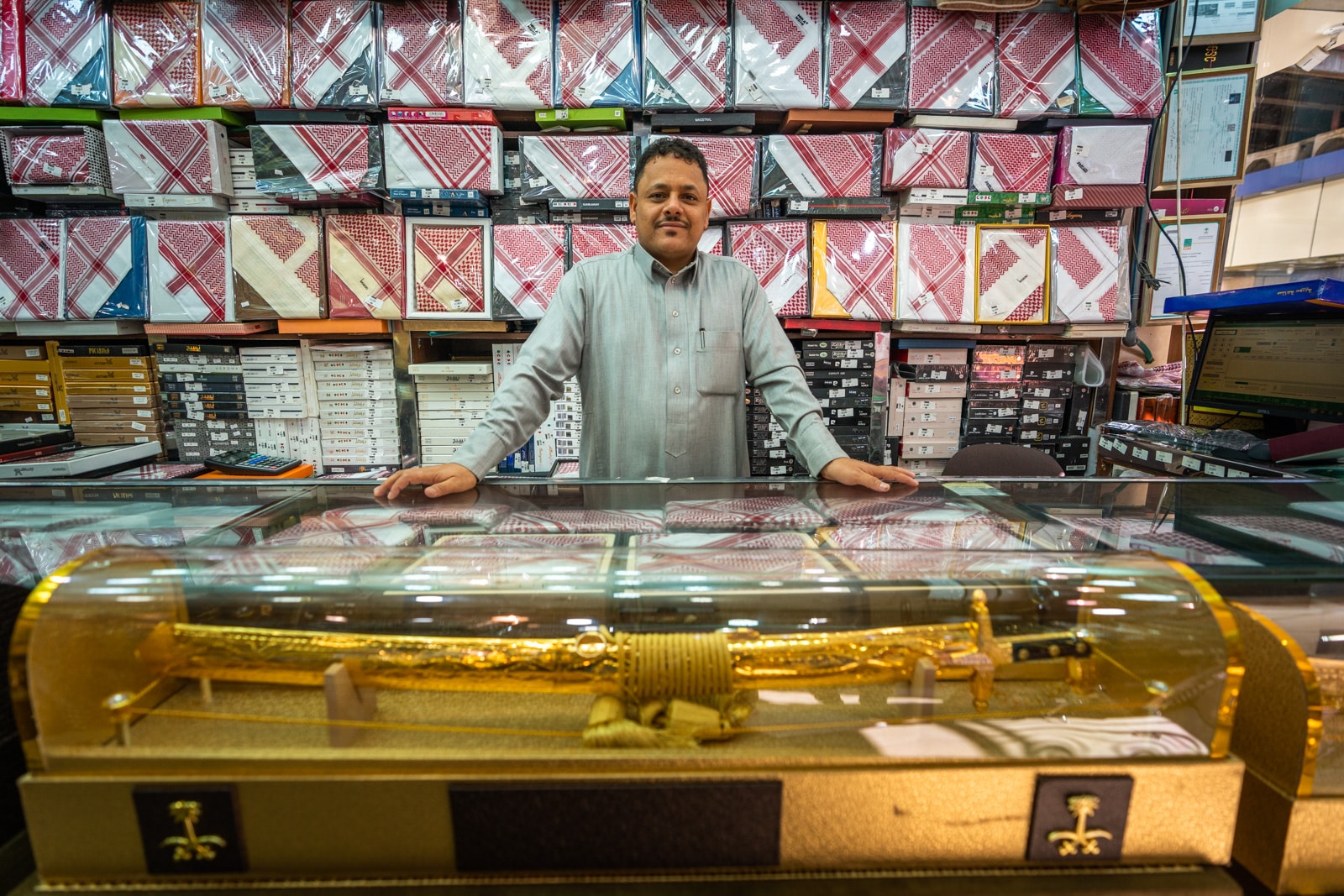
A man selling Saudi ghutra (men’s head coverings) and swords in a bazaar in Khamis Mushait. Nothing like a good sword and robe set as a souvenir for your family back home, eh eh?
Culture in Saudi Arabia
Saudi culture is heavily influenced by several major pillars: Islam, its historic role as a major trade center, and Bedouin (nomadic desert tribes) roots. Generally, Saudi culture is deeply religious, family-oriented, protectively traditional, and socially conservative.
Clothes and what to wear in Saudi Arabia
One of the first things any visitor to Saudi will notice is how many people wear traditional clothes.
Even in major cities like Riyadh and Jeddah most men still wear thobe, the long, loose robes coming to the ankles. The vast majority of women in Saudi Arabia are completely covered in black abayas, long, loose robes for women, and hijab head coverings. Most women cover their faces when out in public.
As a tourist visiting Saudi Arabia, it’s required by law to dress modestly. You don’t have to go out and buy a thob ASAP, but there are some basic requirements to keep in mind.
Men: Men should avoid tank tops or walking around shirtless—t-shirts at the very minimum—and long pants are strongly recommended. Islam requires men’s knees to be covered, and you will stick out like a sore thumb if you walk around in shorts and a wife beater tank.
Women: Though foreign women are no longer required to wear abayas, I still strongly recommend female travelers wear them in public in cities and towns. Unless you’re hanging out with elites or in someone’s home, you will be the only woman not wearing one 99% of the time. You can wear whatever you’d like underneath—I often wore a t-shirt and jeans—but an abaya is ideal. Headscarves are not mandatory, though in many areas I wore one to avoid people’s stares.
Smells in Saudi: Scents and smelling good are highly prioritized in Saudi Arabia. Men and women alike wear scents, cars must smell good, and greeting guests with bukhoor (a sort of goblet-shaped incense holder, usually to burn oud wood) is common. You don’t have to smell like a perfume shop all the time, but know people will be very aware of how you smell. A bit of an embarrassing issue for me, an often-smelly backpacker.
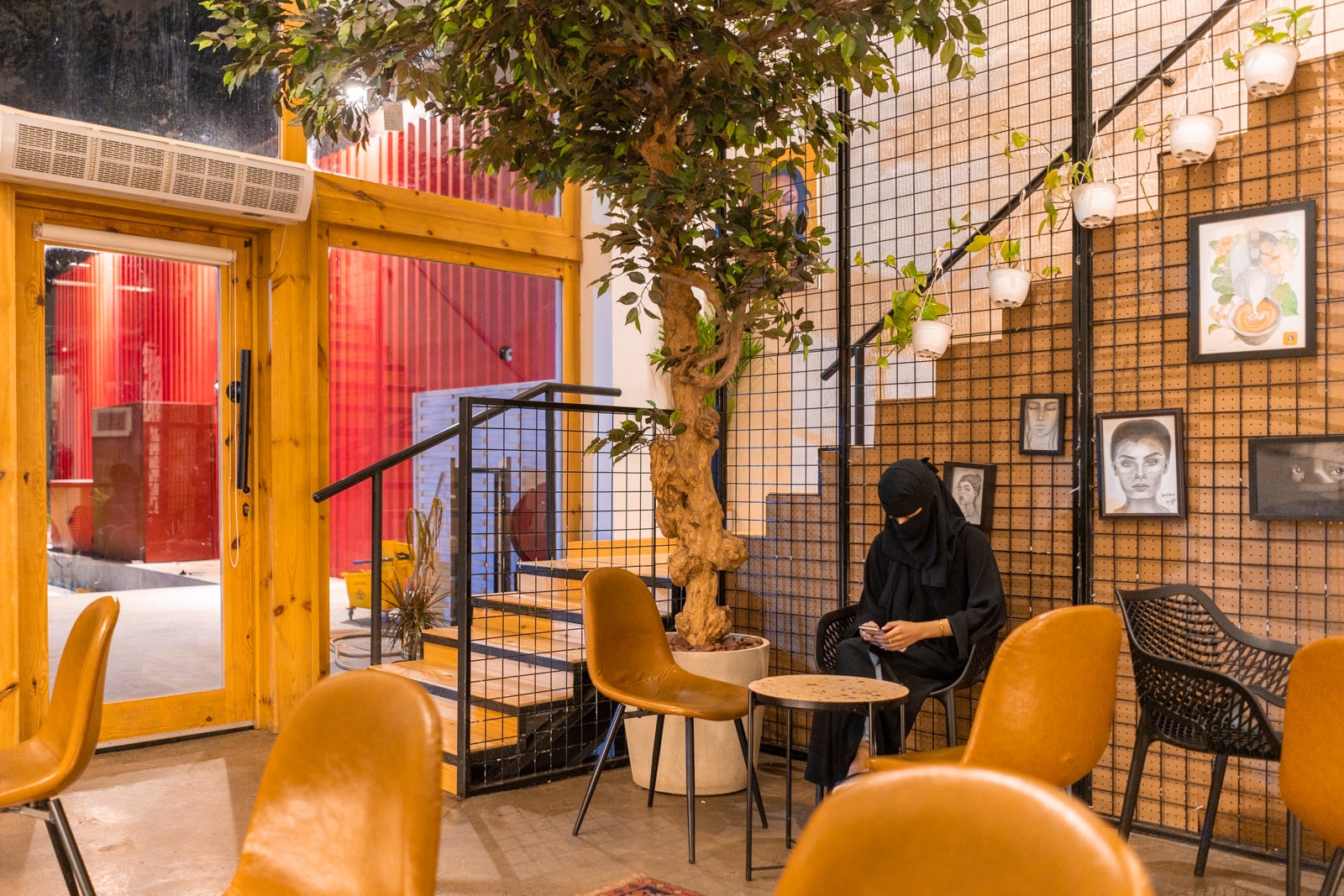
Gender divides and how to act in Saudi Arabia
Saudi Arabia is heavily segregated by gender. Men operate in one sphere, women in another.
Even within families, it is common for women to stay out of sight or hidden from men. I met many men who do not know what their extended female family look like, and women who would cover themselves in front of their husband’s brothers. Just to give you an example of how extreme the segregation can be.
Practically, for travelers the gender divide is most noticeable when it comes to eating. It is no longer required by law, but many restaurants are still divided into men and women/family sections. Some restaurants do not allow women at all. Men cannot sit in the women’s section unless accompanied by women; women usually cannot sit in the men’s sections, though sometimes more progressive restaurant owners will be flexible about the rule if the restaurant is mostly empty.
The extremity of segregation varies around the country. In small towns, you likely won’t see women at all. In Jeddah and wealthy parts of Riyadh, you’ll see more men and women mixing these days.
How to act around the opposite gender is something that varies from person to person. Here are some general tips to keep in mind:
- Do not touch the opposite gender. This includes handshakes; only shake hands if the local offers first, though they probably won’t.
- Try to avoid making unnecessary eye contact with strangers of the opposite gender if you’re not interacting with them, especially as a man. Men can get defensive if you stare at their wives/sisters.
- Don’t sit next to the opposite gender unless you’re with them or related to them.
- No PDAs you traveling couples. Though you’ll see married couples holding hands sometimes, anything beyond that is inappropriate and a punishable offense.

Hospitality and gift giving in Saudi Arabia
Hospitality is another core element of culture in Saudi Arabia.
As in many Islamic societies, guests are seen as a gift from God. Taking care of guests is an opportunity to do good and win favor in the eyes of Allah. When traveling in Saudi Arabia, don’t be surprised if you’re given gifts, taken out to dinner, or shown around for an entire day “because you’re our guest.” Let it be noted that the whiter you are, the more likely this will occur.
You might be tempted to give your hosts a gift as thanks, but you probably shouldn’t. Though they’ll happily shower you with gifts, many Saudis will take offense to gifts given to them by new acquaintances/non-relations. Proper gifts are usually quite expensive—think fancy carpets or expensive scents—so unless you’re visiting a family or long-time friend, don’t feel pressured to bring gifts. Just appreciation.
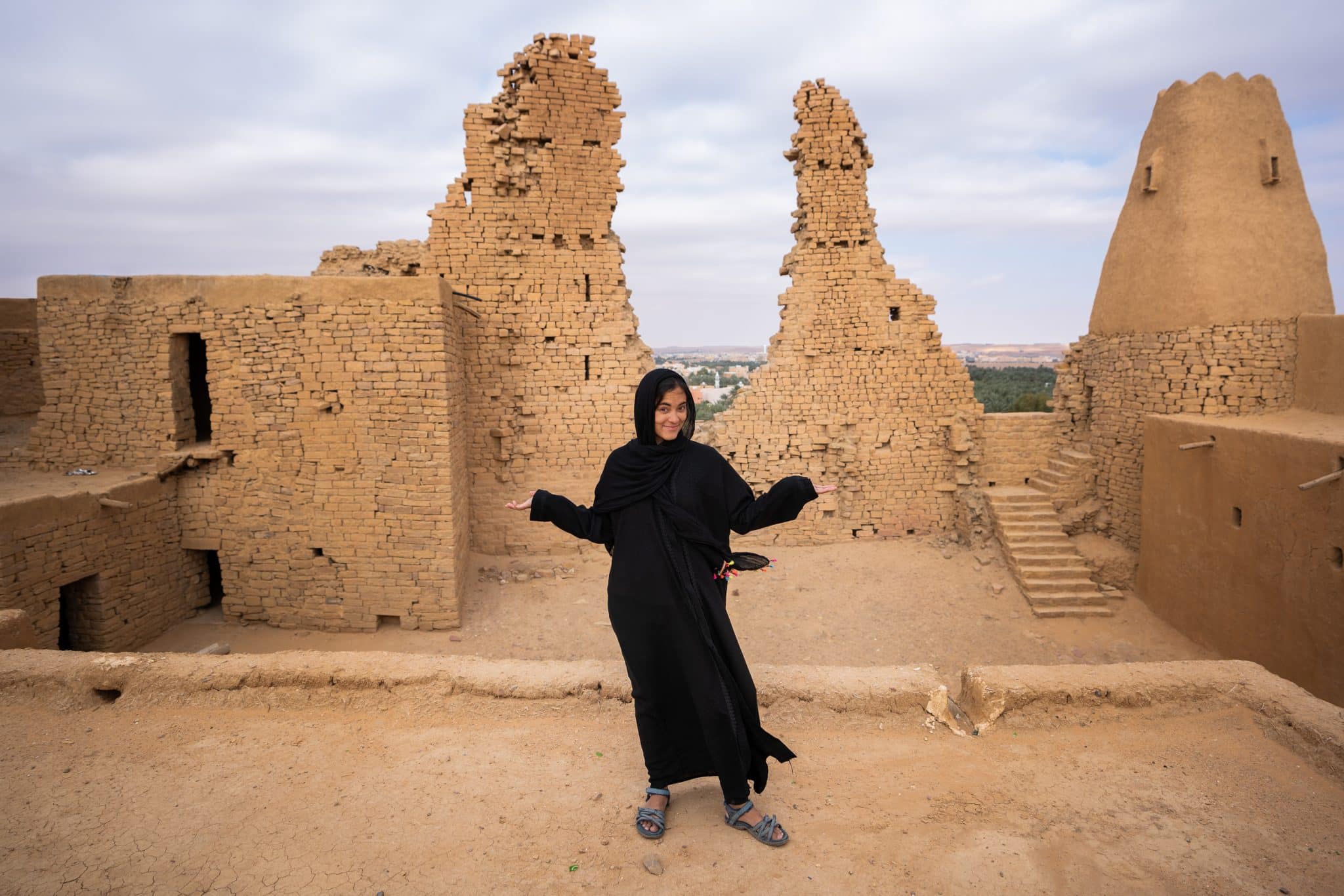
My daily outfit in Saudi: black abaya, headscarf, and whatever clothes were least dirty underneath.
Female travel in Saudi Arabia
Traveling as a woman in Saudi Arabia is worlds apart from traveling as a man.
Even if you’re a female traveler traveling with a man, people will treat you very differently from male travelers. Women are treated with great respect in Saudi Arabia, though “respect” in Saudi Arabia might be viewed as restriction by others.
The status of women in Saudi Arabia is complex—one I’m not exactly qualified to discuss—so let’s stick to practical travel matters. Because genders are so segregated in Saudi, it can be hard to find women to interact with outside of the big cities. You need to be far more attentive to your clothing than men. Finding places to eat that allow women can be a bit of a nightmare in small towns—you’ll have to get used to takeaway meals.
On the “bright” side, because the punishment for harassment is so severe—and official harassment can be something as simple as a man staring at you for too long—female travelers are generally not at risk of more severe assault. I encountered some verbal harassment and men following me, and a few solo female travelers I spoke to were propositioned for sex, but harassment should not be a major concern for female travelers.
In my personal experience, both solo and traveling with men, I often found traveling in Saudi Arabia as a woman to be isolating more than anything else. As a disclaimer, part of that could be attributed to my appearance—most people thought I was either Arab or Indian/Pakistani—as I heard more glowing stories from white women.
I could go on for a long while on female travel in Saudi Arabia, but I’ll stop here. For a more in-depth discussion, check out my guide to female travel in Saudi Arabia.
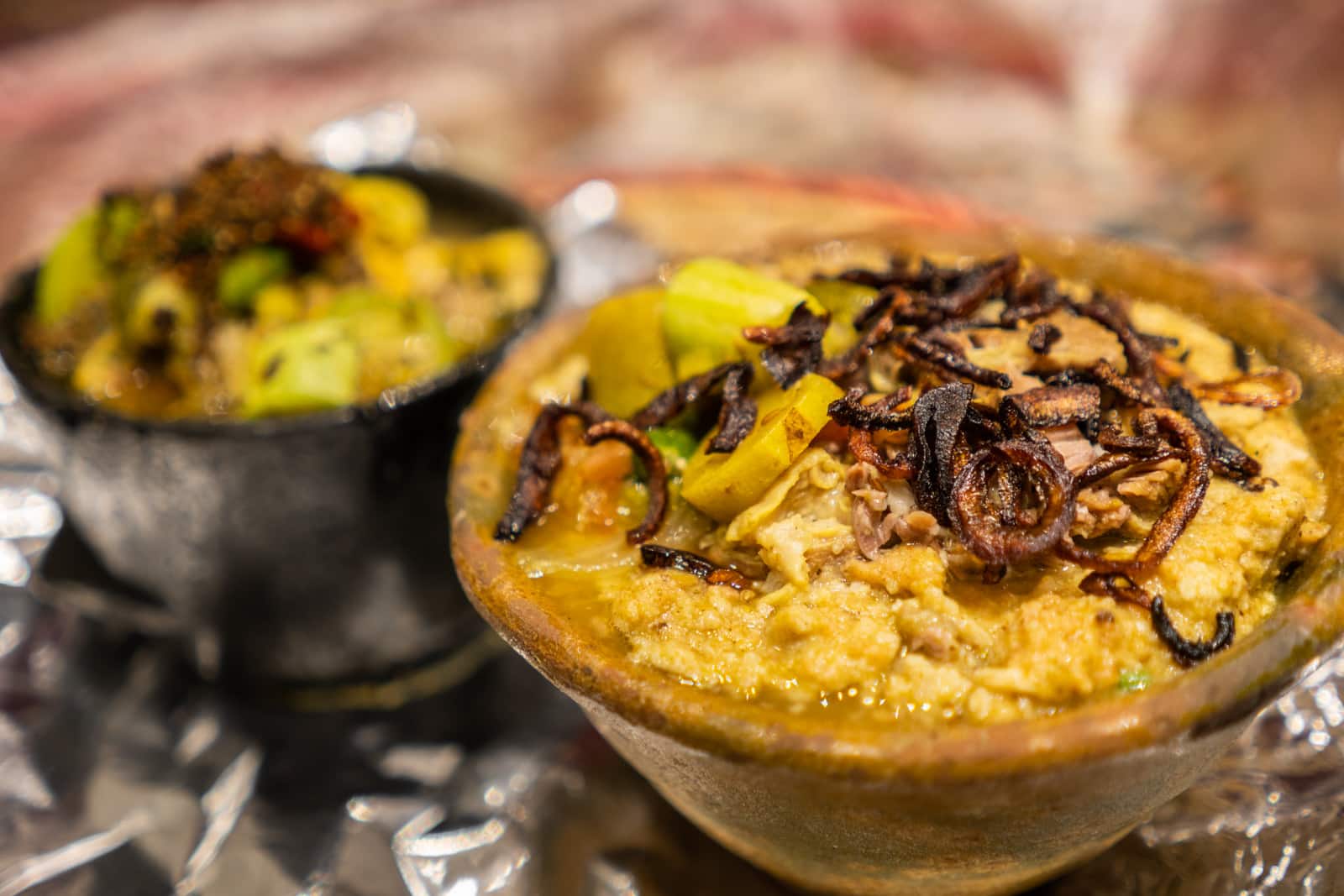
The Yemeni-influenced food in Jazan was 100% my favorite in all of Saudi Arabia. I’m drooling just looking at this.
Food in Saudi Arabia
If you love food, prepare to put on a few pounds in Saudi Arabia. I know I did.
Saudi Arabia has long been a crossroads of cultures. Traders came in by horse and camel from the north, while others came by sea. Muslim pilgrims from all over the world have traveled to Mecca for centuries.
As a result, Saudi cuisine draws on many different influences, and many common dishes in Saudi Arabia actually have origins elsewhere. Fuul (beans), falafel, and shawarma are diet staples, though not traditionally Saudi.
Some traditional Saudi dishes to look out for include:
- Kabsa – Roast chicken and rice found everywhere
- Dates – Saudi Arabia has some of the best dates in the world, and they come in all different types and flavors. The Qassim region is considered to have the best dates in the country.
- Jareesh – Crushed wheat porridge, topped with savory onions and dried limes
- Murtabak – Stuffed pancake
- Tharid – Spicy lamb stew served with bread
- Laban – Creamy yogurt drink
- Mamuul – Stuffed date cookies
- Arabic coffee – Not at all like “normal” coffee, it’s yellow, bitter, and flavored with cardamom
Meals in Saudi Arabia are rich, spiced, and usually accompanied by a mound of rice or bread, as well as thick, creamy laban (a strained kind of yogurt that can also stand alone as a drink—it’s delicious!). Meat is an essential part of main meals, and sweet tea often follows.
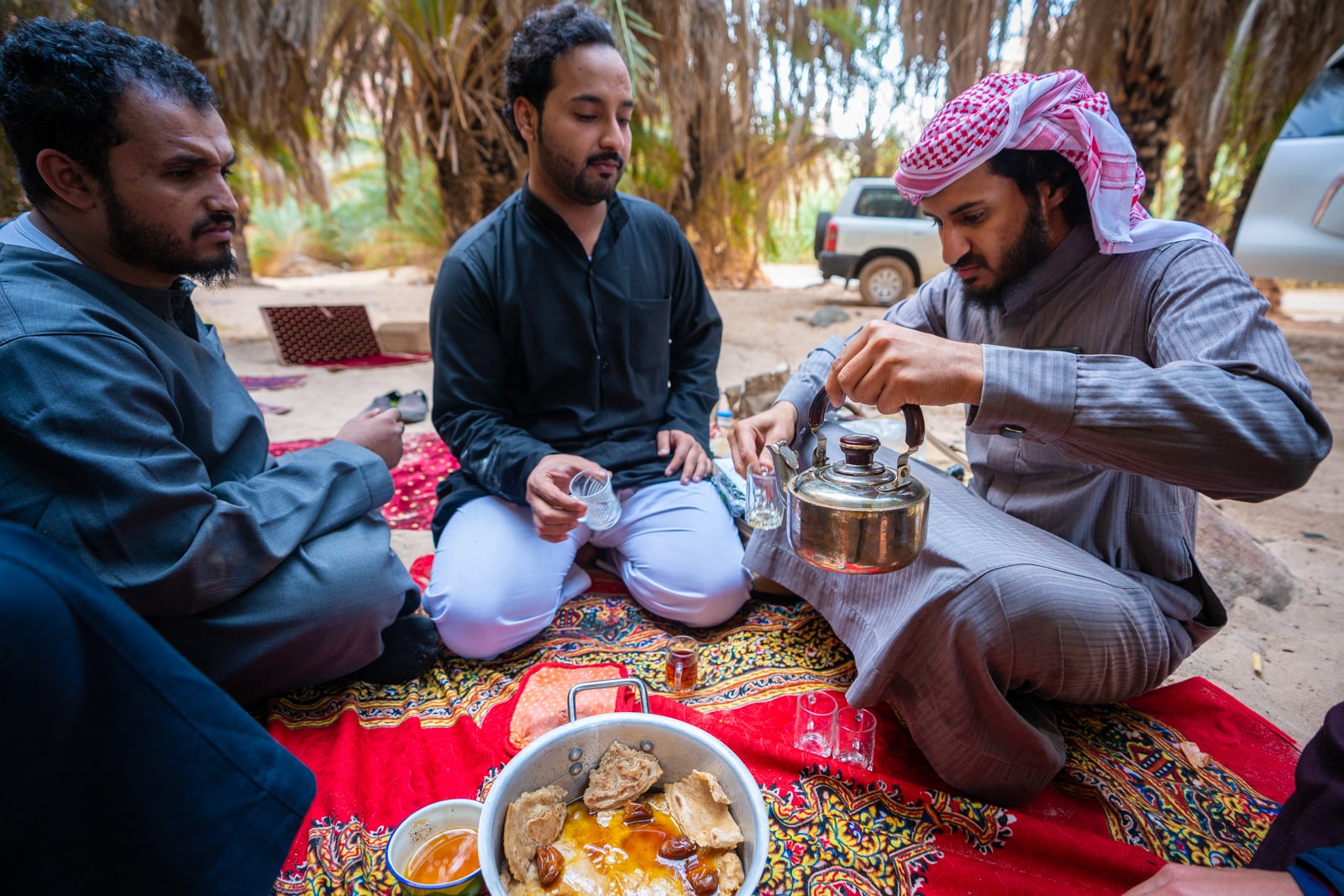
Eating customs in Saudi Arabia
There is definitely a right and wrong way to eat in Saudi Arabia! Though you’ll probably be forgiven for any culinary cultural faux pas as a foreign visitor, it’s still good to respect norms.
Traditionally, meals are eaten on a mat on the ground, and everyone eats from a large, central plate. Usually, there are boxy pillows on the ground you can lean up against for support.
Food is eaten by hand. Don’t worry, washing hands before and after all meals is customary. Eat with your right hand only (left hands are for dirty business), unless doing something more complicated like picking a chicken bone apart. Only pass food with your right hand, even if it’s dirty.
When sitting on the ground, try to keep your legs crossed or knees bent. It’s considered rude to extend your feet in front of people you respect, especially if your feet are pointing towards them.
Saudis will usually press you to eat more, and refill your cup whenever your coffee or tea is finished. It’s expected to let them refill your cup at least once. As for eating, it’s best to start saying you’re full well before you’re stuffed to the brim… else you might be stuffed beyond the brim.
Confused about how to eat? Here’s a video on eating customs in the Middle East to give you an idea of how and why people eat the way they do. The vlogger isn’t Saudi, but the same principles apply.
Traveling as a vegetarian/vegan in Saudi Arabia
Though meat is a meal staple, there are plenty of vegetarian- and vegan-friendly foods to be found in Saudi Arabia if you look.
Some upmarket establishments have vegan options. Vegetarian restaurants exist in big cities. Though you might encounter some raised eyebrows, vegetarians and vegans are increasingly common in Saudi Arabia—one of Saudi’s princes is vegan. In general, people in cities understand what vegetarians are.
Some common foods you can rely on as a vegetarian or vegan (*) traveler include:
- Falafel* (if no yogurt)
- Fuul (beans)*
- Vegetable murtabak (stuffed pancakes)*
- Dal tamiz (lentils with bread)*
- Hummus*
- Moutabel (baba ghanoush)*
- Masoub (Yemeni banana and bread pudding)
Here are more food options for vegetarians in Saudi Arabia.
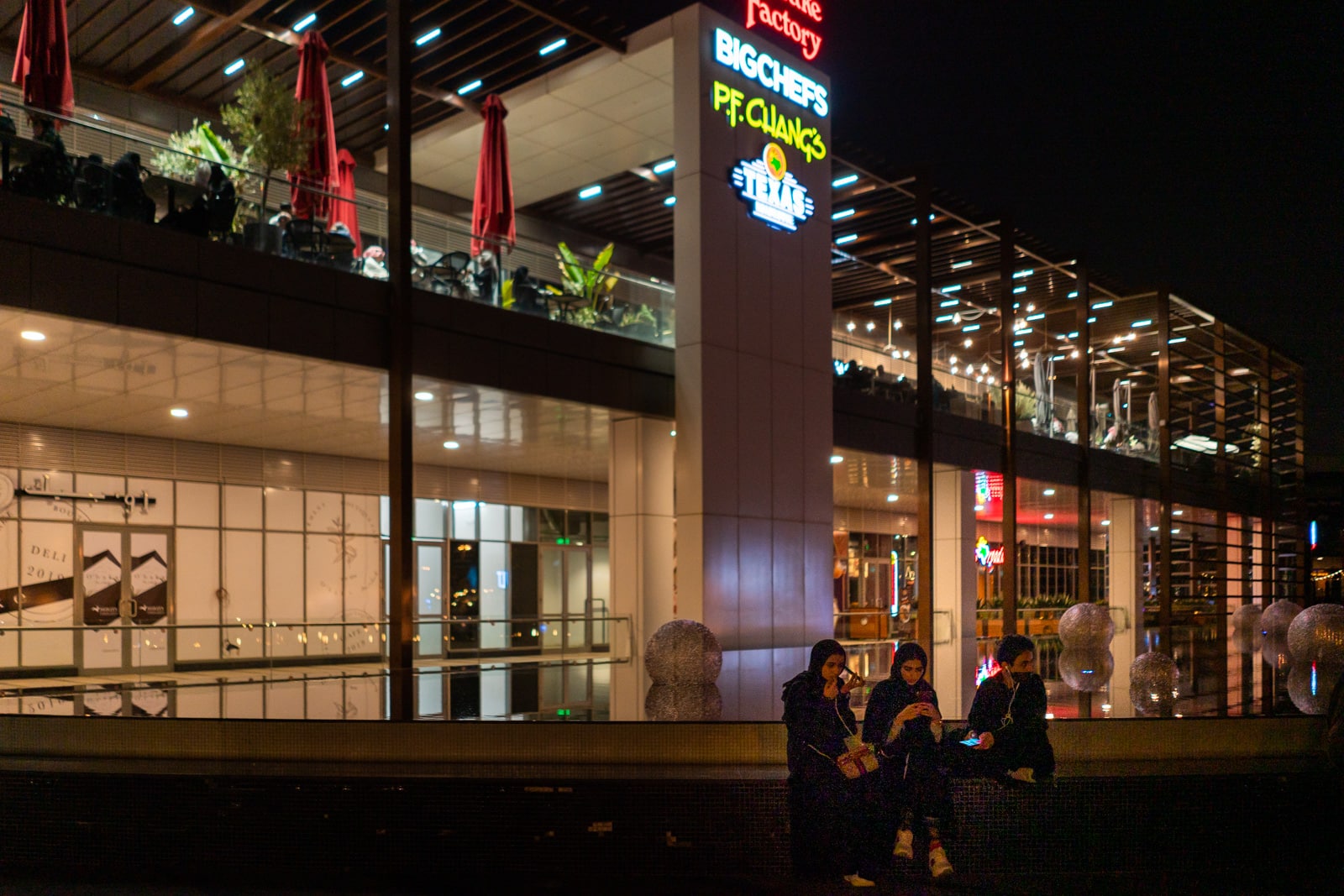
Teenagers hanging out at one of Riyadh’s fanciest malls.
Money and payments in Saudi Arabia
Saudi Arabia uses the Saudi Riyal (SAR). One Riyal is divided into 100 halalas. Saudi has banknotes and coins, although the coins are mostly useless. However, don’t be surprised if you end up with a stack of one and two riyal coins (and a bunch of halalas to boot). At the time of writing, 1 riyal is $0.27 or €0.25. Check here for the current exchange rate.
Paying with credit card
It’s possible to pay by international credit card for most large transactions such as nice meals, car rentals, and hotels. Google Pay is also quite popular in Saudi Arabia—many people just use their phones to pay in cities.
Cash and ATMs
Banknotes come in 5, 10, 50, 100, and 500 riyals. Make sure to withdraw an amount from the ATM that isn’t easily divided into 500 notes; you don’t want to be stuck with a stack of large banknotes. Many places will have some change, but not always enough to break a 500.
Getting money from the ATM is straightforward (there are even drive-through ATMs), and there aren’t any hidden ATM fees to worry about.
Read: How much it costs to travel in Saudi Arabia
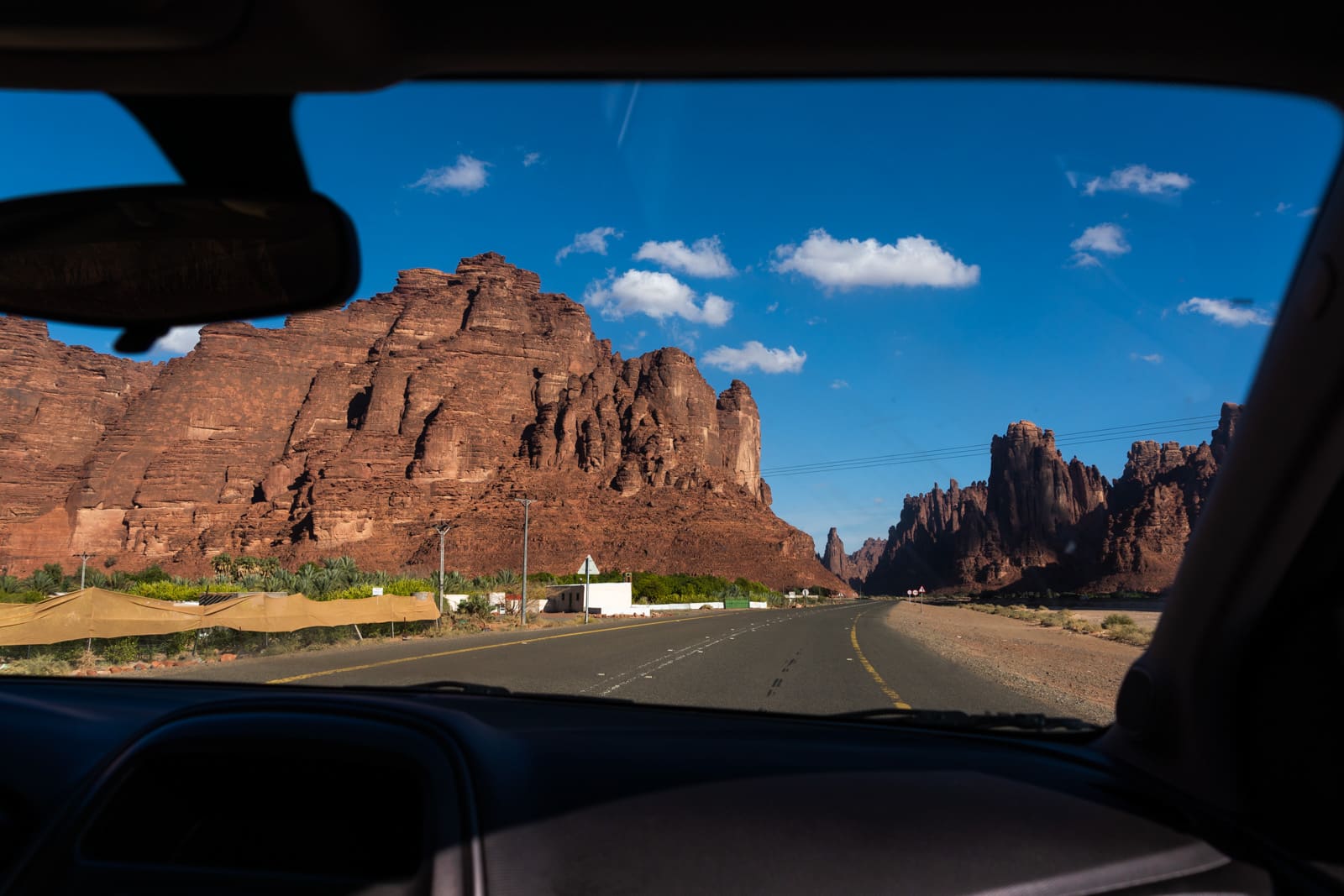
Road tripping into Wadi Disah, one of the most epic canyons in Saudi.
Transportation in Saudi Arabia
Saudi is absolutely massive; getting around takes time. Cities are spread out, and there’s hardly any public transport to speak of. Even between cities—which can easily be more than 500 km apart—public transport is limited.
By rental car
Saudi Arabia is made for cars, especially 4x4s. Saudi’s most memorable spots are all outside the cities; I highly recommend you rent a car to make the most of your trip to Saudi. My guide to road tripping in Saudi has all the information you need.
Note on cars: I’ve heard of unofficial shared taxis offering rides between cities, though I didn’t use any myself. A local told me you can sometimes find them lurking outside of major bus terminals.
By plane
If you’re short on time, or if you only want to visit a few main cities, planes are the most efficient (and often cost-effective) way of getting between cities. Most flights are less than two hours. Some are even cheaper than bus tickets.
By bus
SAPTCO runs an extensive bus network throughout Saudi Arabia. Buses are clean and comfortable, though on the pricey side. Expect to pay at least US$50 per person for a long distance bus ticket.
For more info on traveling by bus in Saudi Arabia, check out the Saudi Arabia Public Transport Company (SAPTCO) website.
Transport within cities
Ride sharing apps Uber and Careem are commonly used in big cities such as Riyadh and Jeddah.
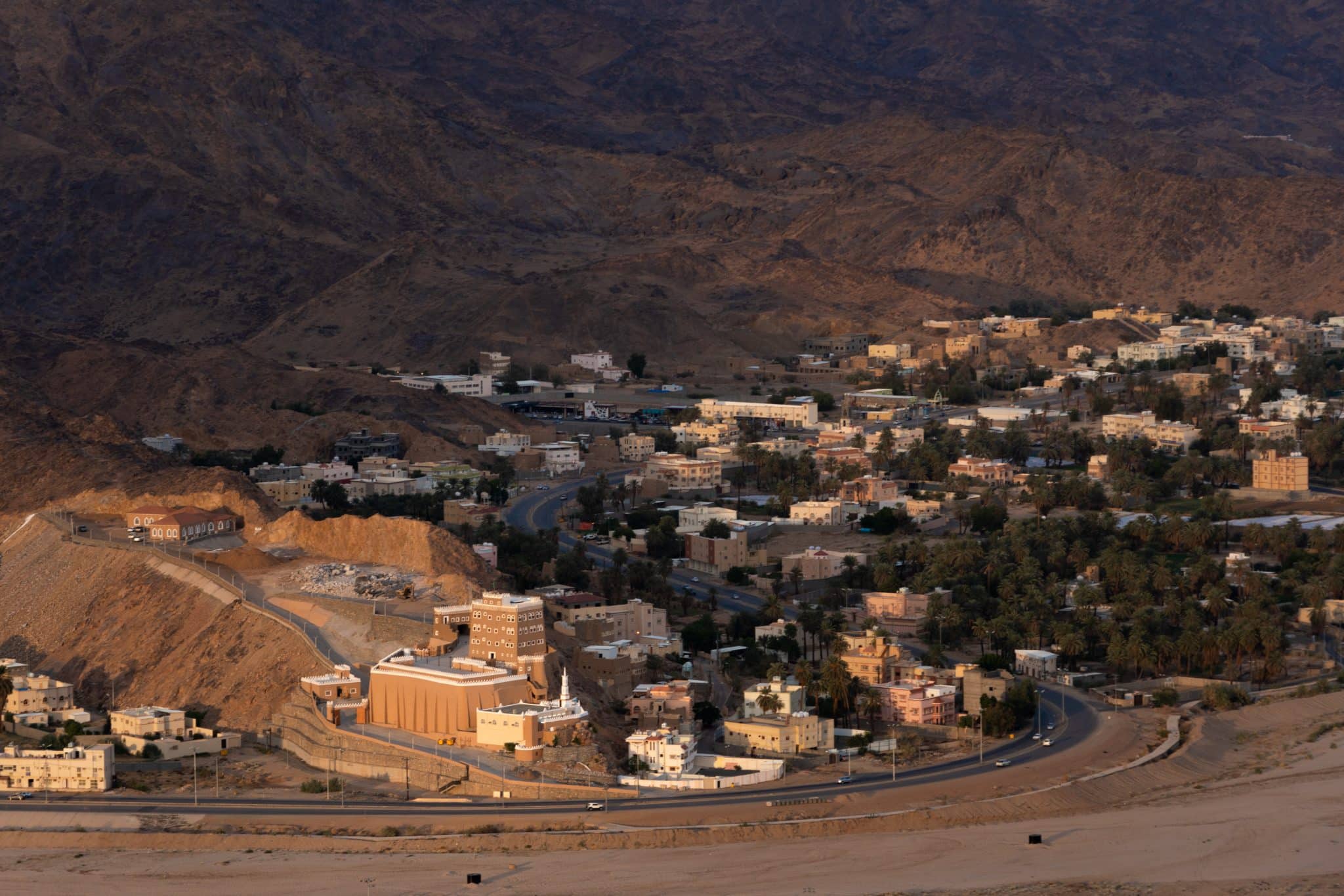
Najran, the Saudi city hardest hit by the war in neighboring Yemen.
Safety in Saudi Arabia
Many people have asked me: Is Saudi safe? I think Saudi is generally a safe place to travel to. Although it’s had problems with violence and terrorism in the past, most areas in Saudi are perfectly safe for the average tourist.
The only area considered dangerous is the area along the Yemeni border around Najran. Tourists are allowed to visit, but most governments advise against travel there. Saudi is currently in talks with the Yemen rebels to negotiate a truce. However, some security experts are fearful the rebels might launch a ground offensive on Najran if their demands aren’t met. If you plan on traveling to the south, make sure to keep an eye on the current situation.
Safety issues for travelers in Saudi Arabia
Drivers are the biggest safety hazard in Saudi Arabia. Many drivers drive like crazy, so be careful when crossing the street or driving around the country.
Openly talking about politics or the royal family with people you don’t know well is not wise. Saudi critics of the royal family have been jailed.
Criticizing Islam is absolutely to be avoided for a variety of reasons.
Drugs, including alcohol, are illegal in Saudi Arabia. They do exist—alcohol is common especially among elite and/or foreign circles and khat is a stimulant commonly consumed in the south—but possession is a punishable offense.

Probs checking his Snapchat; Saudis use Snapchat more than any other social media app for everything from messaging to promoting their business.
Mobiles and connectivity in Saudi Arabia
Saudi is fairly well connected. There’s 4G service almost everywhere, even on long stretches of highway in the middle of nowhere. Many cafes and hotels have decent wifi, though mobile signal is often better.
There are several mobile operators in Saudi Arabia. STC, Mobily, and Zain are the three main operators in the Kingdom. I used both STC and Mobily while in Saudi, and highly recommend using STC.
STC’s coverage is the best of the three; I had 4G practically everywhere, even out in nature. Price-wise, Mobily is slightly cheaper, but has poorer service outside of cities and towns. Zain is the cheapest option, but also has the worst coverage outside metro areas.
If you want to get a SIM card, I recommend getting one upon arrival in the airport (if you fly in). The main carriers all have small offices at arrivals, and it’s easy to get a card here as the workers all speak English. It’s possible to get SIM cards in cities, but only at official stores, and workers will be less likely to speak English.
The price for a SIM card with 10GB data is roughly 160 SAR. A 10GB top up is 100 SAR. For info on costs, check out my Saudi budget report.
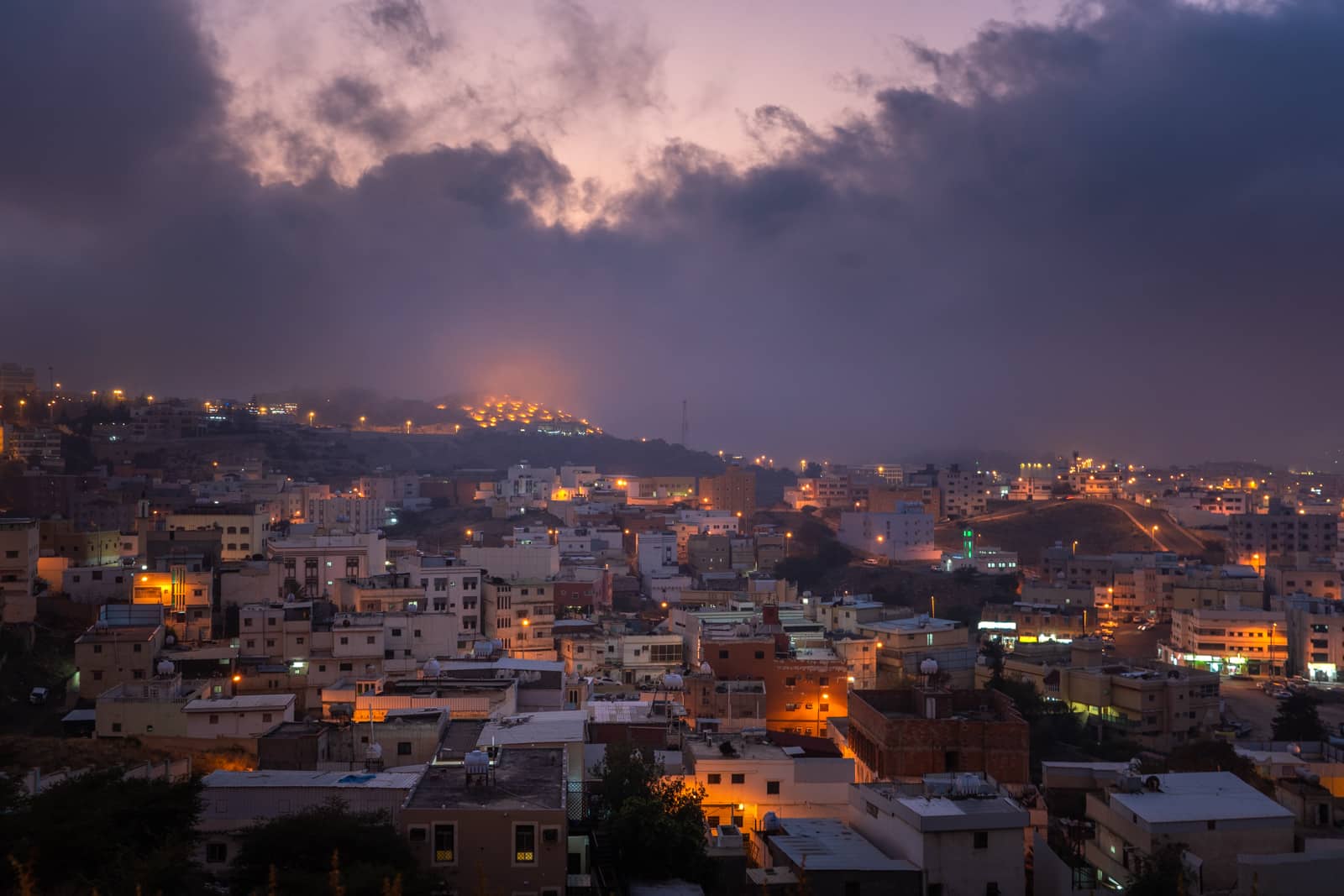
A moody twilight in Abha, a city in the mountains.
More resources for travel in Saudi Arabia
- What it was like to travel Saudi Arabia
- A one-month itinerary for Saudi Arabia
- Guide to female travel in Saudi Arabia
- How much it costs to travel in Saudi Arabia
- Driver’s manual to road tripping in Saudi Arabia
- Nada al Nahdi – Travel blog from a female traveler who was born in Saudi Arabia. Contains some useful itineraries and tips.
- House of Saud – Intriguing documentary explaining the royal family’s power. I recommend watching before visiting.
- Blue Abaya – Popular travel blog by a Finnish expat living in Riyadh
Have more questions? Saudi Arabia travel tips for others? Leave them in the comments!
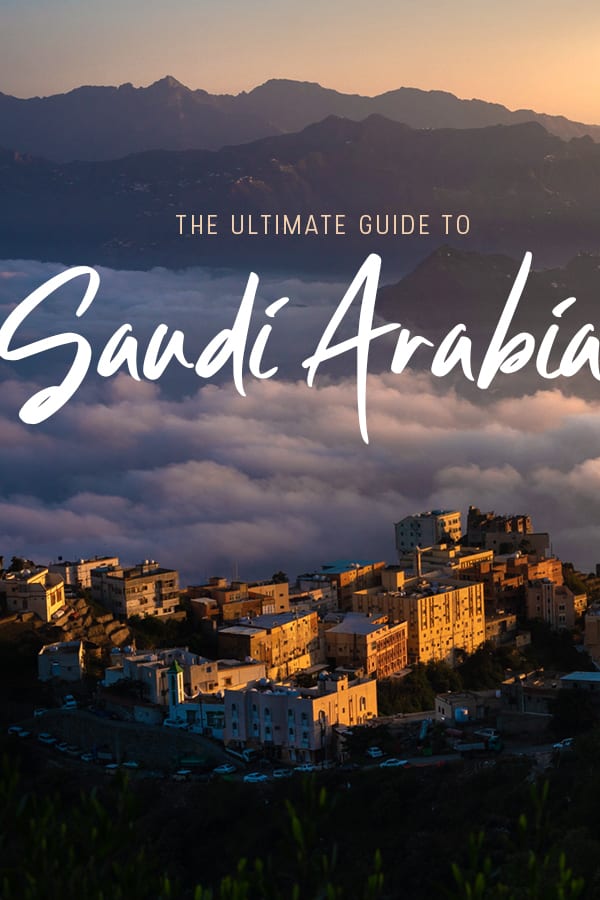
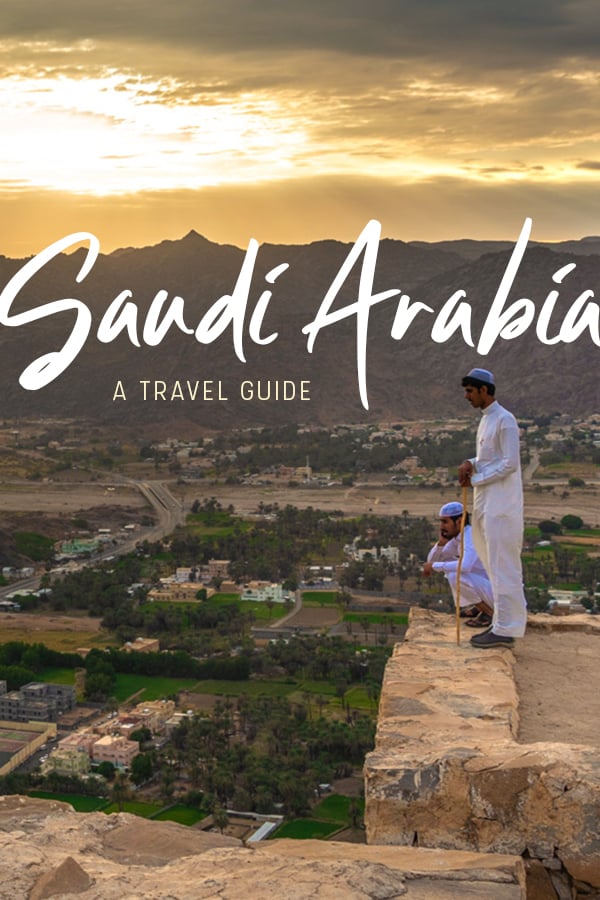
Yay transparency: This post contains affiliate links. If you buy something using my links, I’ll make a bit of extra money at no extra cost to you. It’s how I keep the blog up and running! Never fear, I only recommend things I use or would use myself.
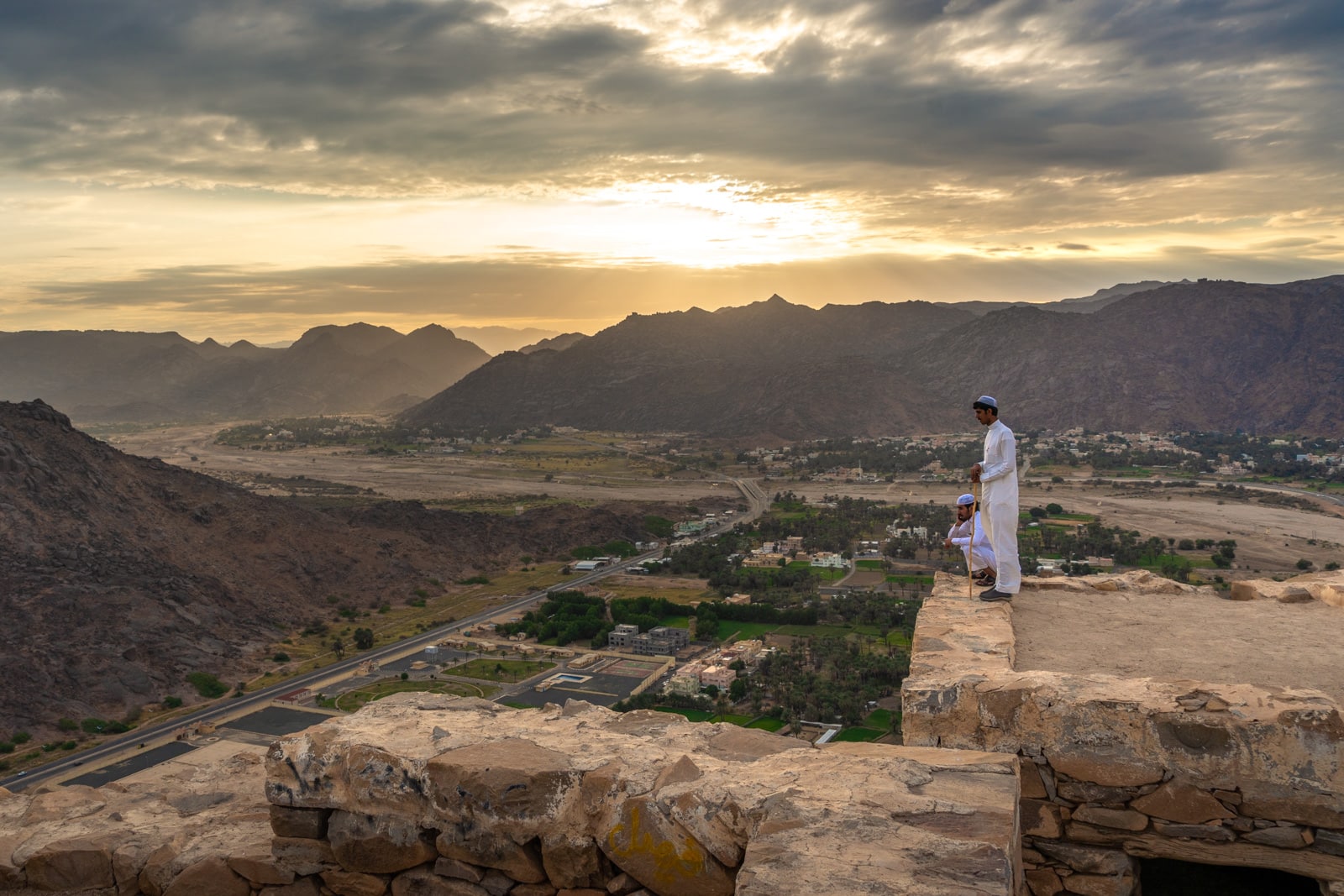


Wonderful post for us. The information you provided is very useful. Thanks for posting it and I am waiting for a more informative post like this, please keep posting.
I’m glad you liked it!
Nice blog. Thank you for sharing this blog.
Super nice guide! And your story-telling is amazing!
Your insights are pretty boring tbh, it seems that you were aiming to visit a place that was similar to the US, thus you were disappointed to find a different culture than yours. Was hoping for something more interesting about the Saudi culture.
God i love you blog and your images are stunning, i grew up in KSA when i was a child. If your ever in bahrain, i would love to invite you todo a podcast with us, we do a blog on site fivestartailoring.com
Wow Alex, well done, you are one very organised lady. Very informative blog.
I’ve been looking at travelling to Saudi for over a year now but just getting serious.
I am Scots but live in England and often travel wearing a Kilt. How do you think they will react? I travelled from Alexandria, Egypt to Cape Town in 2018 and was welcomed everywhere especially Sudan, so happy to try it in Saudi. I think the majority will love it. I found out that everyone seems to have seen “Braveheart, …..Freedom” and they shouted that at me a lot throughout Africa, even in Sudan 🙂
Happy and safe travels to you always
Ged
Very interesting and useful blog post. I’ve done a fair bit of travel in Muslim countries but none as strict as Saudi so your information is really valuable. Not sure if or when I will visit but it’s definitely on my maybe list and good to know some of what to expect if I do go.
Nice post.
Thank you for sharing a informative information with us.
Nice post.
Thank you for sharing a informative information with us.
child porn
==> 88nb.cc/2xj16 url.epoch.tw/JM0oX <==
child porn